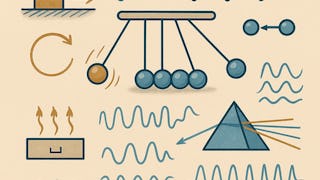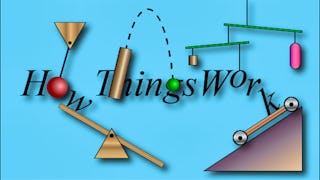Most of the phenomena in the world around you are, at the fundamental level, based on physics, and much of physics is based on mechanics. Mechanics begins by quantifying motion, and then explaining it in terms of forces, energy and momentum. This allows us to analyse the operation of many familiar phenomena around us, but also the mechanics of planets, stars and galaxies.

3 days left: Get a Black Friday boost with $160 off 10,000+ programs. Save now.


Mechanics: Motion, Forces, Energy and Gravity, from Particles to Planets



Instructors: Prof. Joe Wolfe
74,368 already enrolled
Included with
(1,070 reviews)
Skills you'll gain
Details to know

Add to your LinkedIn profile
44 assignments
See how employees at top companies are mastering in-demand skills

There are 8 modules in this course
This introductory section covers some basic tools you will need to solve some of the physics problems we will encounter later.
What's included
5 videos2 readings6 assignments
Here we introduce kinematics, in which we describe and quantify movement of objects through space over time. Motion is so important to mechanics (and most of physics) that we'll spend a few weeks establishing the tools and techniques we'll need. We'll leave explaining motion to the later weeks, starting with Newton's laws in week 4. Here we study the simplest case: motion in a straight line.
What's included
4 videos1 reading5 assignments
Here we look at kinematics in two-dimensions – specifically, projectiles and objects in circular motion.
What's included
4 videos1 reading5 assignments1 peer review
After describing and quantifying motion (weeks 2 and 3), we now start explaining it with Newton's three laws of motion. Knowledge of Newton's laws and the ability to apply them to various situations will allow us to explain much of the motion we observe in the world around us. They are also very important for analysing things (like bridges) that don't move much (a subject called Statics that's important in some Engineering programs). Because Newton's laws are so important, week 4 has five lessons, as well as slightly longer quizzes than the previous chapters.
What's included
7 videos1 reading6 assignments
We return to the difference between weight and mass. We introduce Hooke's law for elastic deformations. We consider forces between objects in contact and (for convenience) resolve them into their normal and frictional components – and as usual give you some problems to solve.
What's included
4 videos1 reading5 assignments
In week 6 we explore work and energy, then power – the rate of doing work. We'll use work and Newton's second law to derive the quantity called kinetic energy. Looking at where work comes from, we'll distinguish two sorts of force – conservative and non-conservative. That will allow us to introduce potential energy and mechanical energy. Power is the rate of doing work. We'll spend some time relating these quantities and their units to your everyday experience, relating Joules to kilowatt hours (the unit used by electricity companies) and kilowatts to horsepower and to human power.
What's included
5 videos1 reading6 assignments1 peer review
It’s time for some smashing fun! Once we've defined momentum we'll use momentum to analyse elastic and inelastic collisions. Stand by for hammers, skateboards, car crashes and a bed of nails…
What's included
4 videos1 reading5 assignments
For as long as history – and probably much longer – people have stared at the planets and stars and wondered. Why do they shine? What keeps them moving? Why don't they fall down? So next is gravity – and how it runs the solar system, the galaxy and the universe. Escape speed, orbits, satellite manoeuvring, black holes: yes, all of the these.
What's included
5 videos1 reading6 assignments
Instructors



Explore more from Physics and Astronomy
 Status: Free Trial
Status: Free TrialRice University

Birla Institute of Technology & Science, Pilani
 Status: Free Trial
Status: Free TrialRice University
 Status: Preview
Status: PreviewUniversity of Virginia
Why people choose Coursera for their career




Learner reviews
1,070 reviews
- 5 stars
80.24%
- 4 stars
13.88%
- 3 stars
2.98%
- 2 stars
0.93%
- 1 star
1.95%
Showing 3 of 1070
Reviewed on Jul 20, 2016
Great course. Good explanations and examples. The quizes and tests are not very easy sometimes, but they do you let think again. Very enjoyable! Just the course I was looking for a long time!
Reviewed on Apr 27, 2020
The course is very useful and is presented in a pleasant way so that we can understand the subject matter clearly and use them in solving real world problems.
Reviewed on Apr 16, 2020
Very informative course and the way the speakers voice out the lesson is not boring and it makes us more energetic to learn Phyiscs

Open new doors with Coursera Plus
Unlimited access to 10,000+ world-class courses, hands-on projects, and job-ready certificate programs - all included in your subscription
Advance your career with an online degree
Earn a degree from world-class universities - 100% online
Join over 3,400 global companies that choose Coursera for Business
Upskill your employees to excel in the digital economy
Frequently asked questions
To access the course materials, assignments and to earn a Certificate, you will need to purchase the Certificate experience when you enroll in a course. You can try a Free Trial instead, or apply for Financial Aid. The course may offer 'Full Course, No Certificate' instead. This option lets you see all course materials, submit required assessments, and get a final grade. This also means that you will not be able to purchase a Certificate experience.
When you purchase a Certificate you get access to all course materials, including graded assignments. Upon completing the course, your electronic Certificate will be added to your Accomplishments page - from there, you can print your Certificate or add it to your LinkedIn profile.
Yes. In select learning programs, you can apply for financial aid or a scholarship if you can’t afford the enrollment fee. If fin aid or scholarship is available for your learning program selection, you’ll find a link to apply on the description page.
More questions
Financial aid available,

